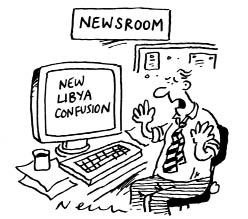It’s tribal and religious divisions that really shape the Middle East – and that account for the Saudi intervention in Bahrain
I once got lost in Asir, the mountainous region on Saudi Arabia’s southwestern border with Yemen. This was the home of many of the terrorists on September 11, from the million-strong al-Ghamdi tribe. But the strangest thing, to me as a westerner, was that I seemed to be the only person who cared which country I was in. I met an elderly man with a garland of flowers in his hair, and asked if I was in Yemen. ‘It’s all the same to us down here,’ he mumbled.
The idea of border police — or, indeed, central government — becomes more blurry the further away from the region’s capitals you head. In Saada, a town on the northern Yemeni border, one can find open-air arms markets where machine guns, hand grenades and even surface-to-air missiles are laid out like fruit and vegetables. Armed tribesmen block the road with boulders, and safe passage has to be secured with bribes. When there is political unrest, it is natural for the West to think about an integral political unit called ‘Libya’ or ‘Iraq’. But to the actors in this drama, very different factors dominate. Much of the Arab world divides itself by tribes.
When civil war broke out in Libya last month, the country quickly split along tribal lines. Even some major oilfields have fallen into the hands of local tribesmen armed to the teeth, and if the country is again to be unified it will only be possible under the leadership of a tribal council. Yemen, the most tribal country in the region — indeed, it has spent only 20 years as a nominal country — is on the brink of revolution, and could well be torn apart again. Should its president, Ali Abdullah Saleh, fall, then it will split again into north and south and there will be fierce inter-tribal clashes.
But arguably the most disruptive force in the region, one woefully misunderstood in the West, is the resurgence of historic Sunni-Shia rivalries centred on Bahrain. The new sectarianism could well precipitate the tribal splintering of Saudi Arabia — a country far more important to the West than Libya in terms of oil supplies and the fight against Islamist terrorism. If the world enters another fuel-price crisis, it is the Sunni vs Shia tension which is likely to be the trigger.
Since the fall of Saddam Hussein, Bahrain is the only Shia-majority Arab country ruled by a Sunni elite. This makes the elite feel understandably vulnerable — and eager to make outside friends, such as the US Navy’s Fifth Fleet, which is based there. The fleet has some 30 warships and 30,000 personnel, and is crucial to Washington’s efforts to contain Iran. Sectarian tension in Bahrain would be seriously disruptive to the western assets in the Persian Gulf. The tiny island is also linked by a causeway to Saudi Arabia’s Eastern Province, which is home to much of the kingdom’s vast oil reserves — and which has a Shia majority with deep grievances against the Sunni overlords.
This motorway was built, it is often said, as a way of allowing sex-starved Saudis to find solace in Bahrain’s brothels. It certainly serves that function admirably, but there is a reason. This causeway gives the Saudi military easy access to Manama, so the Sunni monarchy in Riyadh can rush to defend their Bahraini allies against any Shia uprising. That is what it did this week: one thousand Saudi soldiers took up positions guarding key Bahraini installations as a state of emergency was declared. When the al-Saud ruling family says it will do ‘whatever is necessary’ to prop up Bahrain’s Sunnis, there is reason to believe it.
The Saudis are nervous for good reason. Their arch enemy is the Shia theocracy of Iran, which has historic claims to Bahrain. Iran has forged links with the two million Shia in Saudi Arabia’s Eastern Province, who have close ties to their Bahraini brethren across the causeway. Shia Saudis have been staging demonstration against the House of Saud in the Eastern Province in recent weeks. For the first time, Iran has intervened, warning Riyadh not to crack down and objecting to the Saudi military presence in Bahrain. Hillary Clinton has openly worried about Tehran forging closer ties with a nascent Shia insurgency in both Bahrain and Saudi Arabia.
For Washington to complain about interference in the internal affairs of Arab countries may well be, to many, laughably rich. But there’s no doubting the accuracy of Clinton’s assessment. The mullahs in Tehran, under constant threat of being bombed by Israel because of their allegedly clandestine nuclear programme, have always regarded Bahrain as the great Shia prize. And while the mullahs in Tehran may be cuckoo, they do know their history. In particular, they remember when the Shia in Saudi Arabia’s Eastern Province last rose up en masse against the House of Saud: in support of Iran’s 1979 revolution.
Fear of such a sectarian conflagration in Saudi Arabia is persuading investors to flee the Saudi stock exchange. There is talk about oil prices doubling to $200 a barrel. That could prove an underestimate. If — and it’s still a big if — Saudi Arabia’s Eastern Province witnesses a full-scale uprising, it could well result in the disintegration of the Saudi kingdom along regional, tribal and sectarian lines.
Saudi Arabia was founded in 1932, following decades of massacres of tribal and Shia groups, in addition to pockets of liberal resistance, all of whom were opposed to the hegemony of the House of Saud and the Wahhabi religious hardliners. The Saudi royals have since used brute force to suppress the liberals and Shia, and bought the loyalty of the tribes. But loyalty bought is not as durable as loyalty which is earned. We have seen in Libya, Iraq and in Afghanistan how quickly such tribes can switch sides. Even Gaddafi’s own tribe abandoned him within days. And the House of Saud, a glue that holds together the country it named after itself, is itself riven by splits. Both King Abdullah and his deputy Crown Prince Sultan are gravely ill and a messy succession crisis is looming.
Much of Saudi Arabia’s divided population have been waiting decades for a moment of combustion to reclaim their historic territory. When that happens, there will probably be few opportunities for an optimistic Barack Obama to make speeches about freedom. If the Wahhabi kingdom is torn asunder, the idea of a unifying, liberal, pro-western elite filling the vacuum is inconceivable.






Comments